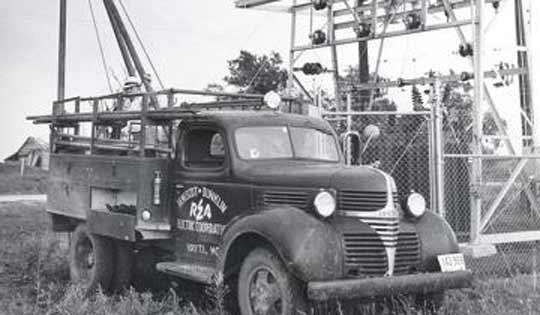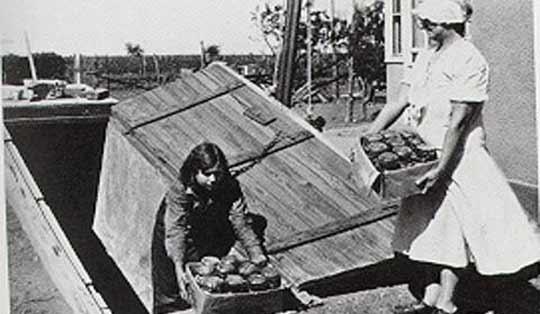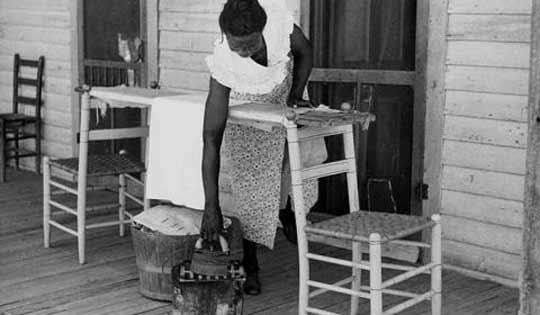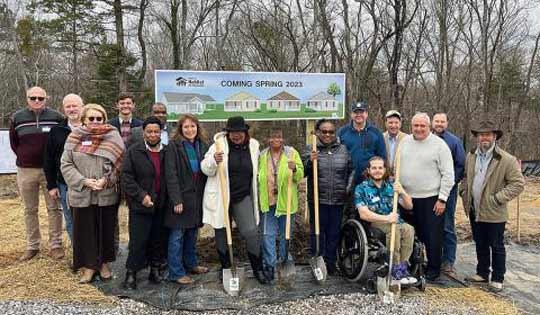History of Rural Development
Who We Are
Rural America is hometown America – more than a great place to live, its people make up America’s spirit and character. Rural people provide the everyday essentials our country depends on and grow our economy.
-
The Story of Rural Development
The U.S. Department of Agriculture’s (USDA’s) Rural Development mission area offers more than 70 programs and initiatives that support rural families and farmers impacted by domestic and global economic issues. However, Rural Development is more than just a set of federal programs. We strive daily to improve the lives of those who live and work in rural communities.
Rural America is important to our nation. Its communities are innovative and resilient. And, rural America has an abundance of natural resources that help ensure our country has the food, fiber, and fuel it needs to power our economy.
Modern-day USDA Rural Development is rooted in the Great Depression and the economic hardship that devastated rural and remote communities largely dependent on agriculture. At this time, 44 percent of the population lived in rural areas and 25 percent of the population were farmers. These conditions illuminated the need for federal policies that prioritized America’s farmers and rural communities.
To pull America out of the depths of the Great Depression, President Franklin D. Roosevelt made the New Deal the centerpiece of his administration. While flawed in its systemic exclusion of communities of color, the New Deal – along with President Lyndon B. Johnson’s War on Poverty programs – gave rural communities the resources they needed to rebuild and thrive. Initiatives included improved access to electricity, water, housing, food, and infrastructure that connected our nation to farmers, ranchers, and others living in rural America. With these investments and clear national policies that addressed the needs of rural communities, farmers, ranchers and their urban neighbors, USDA Rural Development was born.
-
Rural Electrification Administration

Caption: An REA electric truck setting up power lines during the late 1930s.
During the Great Depression, rural Americans needed the power of electricity that had been established in urban areas. Unfortunately, providing electricity to rural places was cost prohibitive and up to 90% of farmers were not able to access electricity because existing distributors would not build lines to their farms. In 1935, President Franklin D. Roosevelt signed an executive order to create the Rural Electrification Administration, which authorized $410 million to provide loans for rural electrification. Following a successful model of electrification through rural electric cooperatives in Pennsylvania, these loans were targeted towards cooperatives whose missions as non-profit organizations made them farmer-focused rather than profit-focused.
Through the new low interest loans, the cooperatives were able to provide affordable electricity to rural areas and their residents.
In 1936, Congress passed the Rural Electrification Act (REA) that codified the executive order and by the end of 1938, 350 cooperative projects in 45 states were delivering electricity to 1.5 million farms. A lot of the success of rural electrification was not just about the availability of funds to cooperatives, but also the technical assistance and outreach provided by the Rural Electrification Administration. The administration had road shows where staff would go to a community and show how electrical equipment worked. There were also community experts like agricultural engineers or home economists who were on the staff of the local rural system to provide technical assistance to consumers.
In six short years, by 1942, nearly 50% of all farms had electricity, and in 1952, almost all farms had electricity. In 1949, telephone cooperatives were brought into the Rural Electrification Administration, and by the mid-1970s, more than 90% of farms had electricity and telephone service. This successful model of relying on rural electric cooperatives to reach rural communities is being replicated today to ensure rural people have access to high-speed internet and all the benefits and opportunities it can bring to their homes and communities.
-
Farmers Home Administration

Caption: A child and mother stock up the cellar with canned foods in the late 1930s
While the Rural Electrification Administration was working to ensure rural Americans had access to electricity, a simultaneous effort was underway to address housing and public infrastructure needs in rural America. In 1935, at the height of the Great Depression, President Franklin D. Roosevelt created the Resettlement Administration through Executive Order 7027 to resettle farmers and migrant workers whose agricultural lands were devastated by drought, particularly those prairies affected by the Dust Bowl. To help improve administration of its programs, the Resettlement Administration was eventually transferred to the Department of Agriculture, established by another President facing incredibly challenging times.
President Abraham Lincoln established the U.S. Department of Agriculture nearly 75 years before the Great Depression and nicknamed it “The People’s Department,” making it a logical home for farmer support programs. The Resettlement Administration became the Farm Security Administration and worked to modernize rural America, encouraging farmers who survived the dust bowl to develop more efficient methods of farming.
At the same time, Congress passed the Bankhead-Jones Farm Tenant Act in 1937 which authorized a credit program to help tenant farmers buy land. When World War II began, the large need for workers to aid the war effort in America’s cities left the Farm Security Administration programs underutilized. In addition, large Southern plantation owners were staunchly resistant to the Farm Security Administration’s support of tenant farmers and sharecroppers. This backlash led the way for the Farm Security Administration to be replaced by the Farmers Home Administration (FmHA), which supplemented grants with loans, and extended credit to farmers, low-income individuals, and the rural elderly not only to buy farmland, but to support development in rural areas. FmHA often became a last option for farmers who could not secure loans elsewhere.
FmHA would go on to encompass much more than farmer support programs. Water facilities and housing programs were eventually added to FmHA , and the Consolidated Farm and Rural Development Act (ConAct) expanded FmHA’s portfolio to include nonfarm enterprises and to expand eligibility to nonfarm rural residents. FmHA was able to deliver these programs through an extensive network of approximately 1,900 county and district offices staffed by more than 9,000 full-time equivalent employees during the 1980s. Today, USDA Rural Development relies on these boots on the ground to engage with farmers, ranchers, and entire rural communities to partner with them and share its resources.
-
The War on Poverty and the Expansion of Rural Policy

Caption: Housewife ironing in Caruthersville, Missouri in the late 1940s.
During the latter half of the twentieth century, President Lyndon B. Johnson made addressing urban and rural poverty one of the top goals of his presidency. The Johnson Administration understood that rural poverty factored in the out-migration of African Americans from the South to urban cities. It also understood existing agricultural policies were insufficient, on their own, to support rural residents.
Recognizing that rural poverty did not always fall within political boundaries such as state lines, the Johnson Administration addressed these issues regionally.
Their focus on regionalization led to the creation of the Appalachian Regional Commission – a collaborative partnership among 13 eastern states – to promote prosperity across all member states.
The Johnson Administration also created the Rural Community Development Service which centralized the functions of rural economic development under one federal-level umbrella. The service functioned similar to the U.S. Department of Commerce’s Economic Development Administration (EDA). However, the Administration encountered jurisdictional battles between USDA and other organizations – such as the Office of Economic Opportunity – created from President Johnson’s “War on Poverty.”
With a change in administrations, President Johnson’s War on Poverty morphed into President Richard Nixon’s focus on the private sector to promote economic growth. The Consolidated Farm and Rural Development Act of 1972 was the authorizing statute for some of USDA Rural Development’s signature lending and grant programs. These include the Community Facilities Loan program, Rural Business and Industry Loan Guarantee program, and Rural Business Enterprise Grant program.
In 1980, under President Jimmy Carter’s leadership, USDA was officially designated the department to coordinate federal rural policy. This led to the creation of a USDA Undersecretary of Agriculture for Small Community and Rural Development.
While President Ronald Reagan agreed that rural policy was important, his administration enacted significant cuts in rural development programs as part of an effort to reduce the overall size of federal government. During this decade, federal spending on USDA rural programs fell by more than 50 percent. The goal of the Reagan Administration was to shift responsibilities to state and local governments and to the private sector. However, this led to a reduction in critical local services and curtailment of rural economic development plans.
-
Creation of the USDA Rural Development Mission Area

Caption: Introducing the next generation the power of clean energy.
When President William J. Clinton assumed the presidency in 1992, he tasked his Vice President Al Gore to conduct a government performance review to find opportunities for introducing efficiencies within the federal government. This six-month review concluded in a report called the National Performance Review which called for a government that works better and costs less. The goals of this effort were to continue reducing the size and scale of government, while modernizing and improving the performance of government. The report called for USDA to close 1,200 of its field offices while concentrating its activities on six key functions: commodity programs, rural development, nutrition, conservation, food quality, and research.
The Federal Crop Insurance Reform and Department of Agriculture Reorganization Act of 1994 was the legislation that implemented the actions from the report and separated farm policy from rural policy through the creation of the USDA Rural Development mission area. FmHA farm loan programs were merged with what was the Agricultural Stabilization and Conservation Service to ultimately create what is now Farm Service Agency. USDA Rural Development assumed administration of FmHA’s non-farm functions, comprised of three agencies: Rural Housing Service (RHS), which took the housing and community programs from FmHA, Rural Business-Cooperative Service (RBCS), which merged the business programs from FmHA with the cooperative marketing division known as the Agricultural Cooperative Service, and Rural Utilities Service (RUS), which took the electric and telecom programs from the Rural Electrification Administration and the water programs from FmHA.
This legislation provided an opportunity to consolidate the collection of rural-specific programs and create a mission area that was not just an outgrowth of farm-focused policies. This allowed for better leveraging of programs to more effectively serve the needs of people living in rural America.
-
USDA Rural Development in the 21st Century

Caption: Diana Randall, Amy Randolph, Inette Brown and Zach Kowalski hold shovels in this group photo of the groundbreaking for their new homes
Today, USDA Rural Development operates more than 70 programs, delivers over $40 billion a year in loans, loan guarantees, and grants to rural communities, and manages a $200 billion loan portfolio. While there are more than 400 rural-centric programs and initiatives across the federal family, USDA Rural Development is proud of its rural-only portfolio. In fact, our Water and Waste Disposal Loan and Grant program is the only of its kind in the U.S. Our programs include high-speed internet expansion, renewable energy system installations, and other projects inconceivable during the Great Depression.
With 47 state and U.S. territorial offices and dozens of field offices, USDA Rural Development engages with diverse communities throughout the United States and its territories. We’ve also created new divisions – such as the Innovation Center and Business Center – that help us improve service delivery and efficiency.
From our New Deal roots in defining rural policy, to today’s comprehensive and forward-leaning mission area, USDA Rural Development offers an array of tools to help grow rural prosperity. What sets Rural Development apart among federal agencies is that its mission is driven by thousands of USDA employees who work and live alongside the people they serve. These employees not only handle the “nuts and bolts” of loan and grant processing, they also share information that helps rural residents access a variety of other federal, state, and nongovernment resources. Our field-based structure allows USDA Rural Development to administer its own programs and coordinate rural policy across the entire Federal Government. Even so, we understand that a rising tide doesn’t necessarily lift all boats, and we acknowledge there is much more work to be done.
In honoring the diversity and vibrancy of rural America – and by collaborating with rural people who understand the unique strengths and needs of their own communities – Rural Development fulfills its mission. The impact of our programs and services is noteworthy, because – together – we understand that when rural people thrive, all of America thrives.
